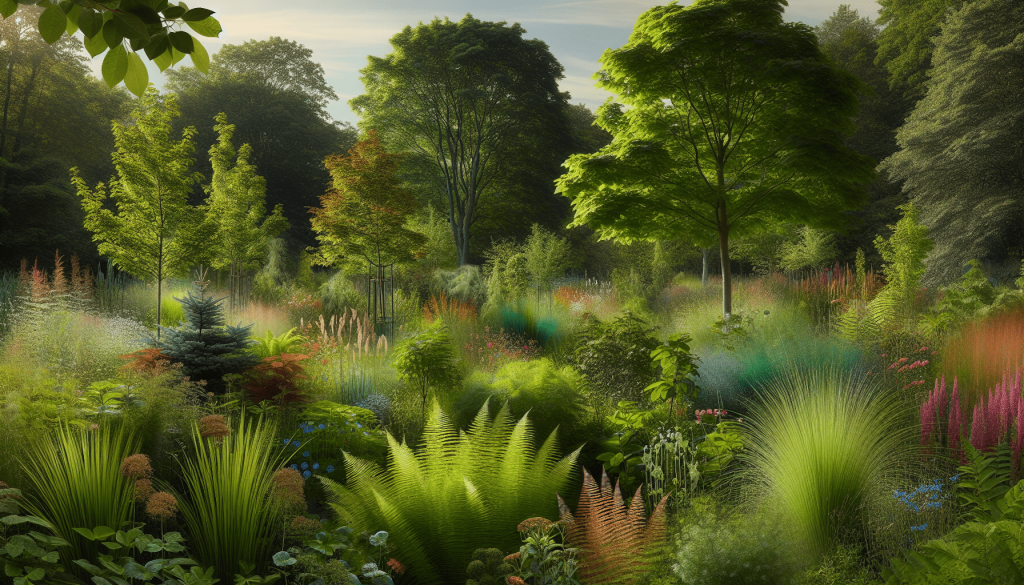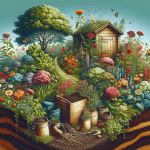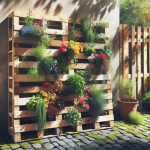This post may contain affiliate links. As an Amazon Associate, we may earn commissions from qualifying purchases.
Did you ever think about how nature manages to grow such resilient and vibrant ecosystems without anyone lifting a finger? If you’ve ever strolled through a lush forest or admired a thriving meadow, you might have wondered how it all comes together. Nature’s secret sauce is something called a “guild,” and believe it or not, we can borrow this natural strategy to cultivate our gardens and farms more efficiently.
What Is a Plant Guild?
First things first, let’s unpack this term. A plant guild is a group of plants that work together harmoniously, each fulfilling a specific role to benefit the whole. Think of it like a highly functional family where everyone pitches in for the common good. Unlike monocultures, which focus on a single crop, plant guilds mimic the diversity and interactions found in natural ecosystems.
Characteristics of a Plant Guild
Plants in a guild each bring something unique to the table, and their roles generally fall into specific categories:
- Nitrogen Fixers: These plants, like legumes, convert atmospheric nitrogen into forms that plants can use.
- Dynamic Accumulators: Species such as comfrey draw up nutrients from deep in the soil, making them available to other plants.
- Attractors: Attracting beneficial insects, these plants such as yarrow or dill help with pollination and pest control.
- Repellers: Plants like garlic or marigold repel harmful pests.
- Ground Cover: Low-growing plants like clover help suppress weeds and protect soil from erosion.
- Support Plants: Certain plants, like sunflowers, can physically support other plants that need to climb.
| Category | Example Plants | Function |
|---|---|---|
| Nitrogen Fixers | Legumes, clover | Convert nitrogen for plant use |
| Dynamic Accumulators | Comfrey, yarrow | Bring nutrients from deep soil layers |
| Attractors | Dill, lavender | Attract beneficial insects |
| Repellers | Garlic, marigold | Repel harmful pests |
| Ground Cover | Clover, creeping thyme | Suppress weeds, protect soil |
| Support Plants | Sunflower, corn | Provide physical support |
Benefits of Plant Guilds in Permaculture Design
So, you may be wondering, what’s in it for you if you adopt this approach? The benefits are vast and multifaceted, much like the plant guilds themselves. Using plant guilds offers a sustainable and low-maintenance way to garden or farm.
Enhanced Soil Quality
Plant guilds contribute to better soil health in a variety of ways. Nitrogen fixers enrich the soil, dynamic accumulators bring up valuable nutrients, and ground cover plants protect the soil from erosion. This means that over time, your soil becomes more fertile without the need for artificial fertilizers.
For example, let’s say you have a garden patch. By planting legumes to fix nitrogen, comfrey to bring up nutrients, and clover as ground cover, you create a self-sustaining ecosystem. Your soil gets richer each season, reducing the need for external inputs.
Pest Control Without Chemicals
Traditional agriculture often relies on chemical pesticides, which can be harmful to both the environment and human health. Plant guilds offer a natural solution. Attractors draw in beneficial insects like ladybugs that can keep pests in check, while repellers naturally deter harmful insects.
In a permaculture garden, planting dill or lavender can attract pollinators and other helpful insects, while placing marigolds nearby can keep nematodes at bay. This creates a balanced ecosystem where you’re less likely to see pest infestations.
Reduced Maintenance
The self-sustaining nature of plant guilds means less work for you in the long run. Because these plants are selected to work together, they require less intervention. Ground covers like clover suppress weeds, reducing the need for constant weeding. Plants that fertilize each other eliminate or reduce the need for frequent fertilization.
Increased Yield
By maximizing the use of space and resources, plant guilds can help increase your yield. The diversity of plants means they use different levels of soil and nutrients, ensuring that the maximum amount of photosynthesis and nutrient uptake can occur. This can lead to higher productivity per square foot compared to traditional monocultures.
Imagine a guild with corn providing support, squash covering the ground, and beans fixing nitrogen. Each member of this guild uses a different part of the space and resources, leading to a bountiful harvest.
Biodiversity and Resilience
Plant guilds inherently boost biodiversity, which is great for the environment and makes your garden more resilient. Diverse ecosystems are less susceptible to disease and pest outbreaks. If one species falls prey to an issue, the other species in the guild can continue to thrive, making the entire system more resilient.
Practical Steps to Implement Plant Guilds
Knowing the benefits is one thing, but how do you actually put plant guilds into practice? Here are some steps to get you started on your permaculture journey.
Assess Your Space
Before doing anything else, evaluate your garden or farm. Note the sunlight, soil type, climate, and existing plants. This information will help you choose appropriate plants for your guild.
Choose Your Key Plant
Start by selecting the central element of your guild, often called the “nucleus.” This could be a fruit tree or a vegetable plant that you want to prioritize.
For example, if you want to build a guild around an apple tree, this tree will be your nucleus.
Select Supporting Plants
Next, choose plants that will support your nucleus based on the categories we discussed earlier. Here’s an example guild for an apple tree:
- Nitrogen Fixer: White clover
- Dynamic Accumulator: Comfrey
- Attractor: Yarrow
- Repeller: Garlic
- Ground Cover: Creeping thyme
- Support Plants: Corn (if applicable, though this might not always be necessary for trees)
| Role | Plant |
|---|---|
| Nitrogen Fixer | White clover |
| Dynamic Accumulator | Comfrey |
| Attractor | Yarrow |
| Repeller | Garlic |
| Ground Cover | Creeping thyme |
| Support Plants | Corn (optional) |
Plant and Mulch
Once you’ve selected your plants, the next step is to plant them in a way that mimics natural ecosystems. Mulching is crucial here, as it protects the soil, retains moisture, and reduces weed growth. As your guild matures, the plants will begin to support one another.
Monitor and Adjust
Finally, keep an eye on your guild. Watch how the plants interact and be prepared to make adjustments. Permaculture design is dynamic; it evolves over time. Observing and tweaking your plant guild will ensure that it remains healthy and productive.

Real-Life Examples and Success Stories
Looking to others for inspiration can be incredibly motivating, especially when you’re benchmarking your own success. Here, we’ll explore some real-life examples where plant guilds have made a significant impact.
The Three Sisters: A Historical Model
One of the most well-known plant guilds dates back to Native American agricultural practices: the “Three Sisters.” This guild consists of maize (corn), beans, and squash. Corn provides a structure for the beans to climb, beans fix nitrogen in the soil, and squash acts as a ground cover to suppress weeds.
- Maize acts as the nucleus plant providing a trellis for beans.
- Beans serve as nitrogen fixers.
- Squash provides ground coverage, acting as both a weed suppressant and a humidity retainer.
Urban Permaculture: The Dervaes Family
The Dervaes family in Pasadena, California, turned their 1/10-acre property into a thriving urban homestead. Through the use of plant guilds and other permaculture principles, they produce over 7,000 pounds of organic produce annually. Their urban guilds include a variety of vegetables, fruit trees, and support plants, all working together to create a productive ecosystem.
Martin Crawford’s Forest Garden
Permaculture pioneer Martin Crawford has a remarkable forest garden located in Devon, UK. His two-acre garden mimics a natural woodland ecosystem. By using plant guilds, Crawford has created a self-sustaining garden that requires little maintenance. His forest garden includes layers of plants, from canopy trees to ground cover herbs, all working together harmoniously.
Tenth Acre Farm: A Residential Example
Amy Stross of Tenth Acre Farm in Ohio has successfully used plant guilds to transform her suburban yard. Her plant guilds include dwarf fruit trees as the nucleus, underplanted with companions like comfrey, chives, and clover. The result? A productive and beautiful permaculture garden that also serves as a learning tool for her community.
| Example | Location | Key Elements |
|---|---|---|
| Three Sisters | Native America | Corn, beans, squash |
| Dervaes Family | Pasadena, CA | Urban homestead with diverse vegetables |
| Martin Crawford | Devon, UK | Forest garden with multi-layered plants |
| Tenth Acre Farm | Ohio, USA | Suburban yard with dwarf fruit trees and underplanting |
Addressing Common Misconceptions
When you first encounter the concept of plant guilds, it’s easy to make assumptions or have questions. Let’s address a few common misconceptions that people often have.
Isn’t It Complicated?
At first glance, plant guilds can seem complex. The idea of managing a small ecosystem might feel overwhelming. However, once you get the hang of it, it’s quite intuitive. Start with a small guild and build from there. The benefits far outweigh the initial learning curve.
Won’t My Garden Look Messy?
If you’re accustomed to the clean lines and symmetry of traditional gardening, a plant guild might initially appear chaotic. However, nature’s apparent “messiness” is its strength. Over time, you might find this natural aesthetic more appealing, and your garden will undoubtedly be healthier and more productive.
Can It Work in Any Climate?
Plant guilds can be adapted to virtually any climate. The key is selecting plants suited to your local conditions. While the specific plants may differ, the functional roles they fulfill remain the same. Whether you’re in a tropical, arid, or temperate zone, there’s a plant guild for you.
Will It Attract More Pests?
This is a common concern, but the opposite is often true. A diverse ecosystem is less likely to experience pest infestations than a monoculture. The various plants and beneficial insects in a guild create a natural balance that keeps pests in check.

Getting Started: Resources and Next Steps
Now that you’re excited (hopefully!) about the potential of plant guilds, where do you go from here? Here are some steps and resources to help you embark on your permaculture journey.
Books and Online Resources
Several books can provide you with in-depth knowledge:
- “Gaia’s Garden” by Toby Hemenway
- “Permaculture: A Designer’s Manual” by Bill Mollison
- “Forest Gardening” by Robert Hart
Online Communities and Courses
Engaging with like-minded individuals can offer valuable insights and support. Online forums, social media groups, and local permaculture clubs can be good starting points. There are also numerous online courses that cover everything from basic principles to advanced techniques.
Permaculture Design Certificate (PDC)
If you’re looking to dive deeper, consider obtaining a Permaculture Design Certificate. This extensive course teaches you the core principles and techniques of permaculture, including how to design and implement plant guilds.
Experiment and Record
No amount of reading can replace hands-on experience. Start small with one or two plant guilds and observe how they perform. Keep a garden journal to record your observations, successes, and failures. This will be an invaluable resource as you expand your efforts.
Final Thoughts
Using plant guilds in permaculture design is like shifting from the role of a controlling manager to a collaborative team builder. The result is a healthier, more resilient garden that requires less effort over time. The benefits are multiple: enriched soil, natural pest control, lower maintenance, increased yield, and enhanced biodiversity.
While the idea of setting up plant guilds might seem a bit daunting at first, you’ll soon find that it’s not only feasible but also incredibly rewarding. By mimicking the intricate and successful systems found in nature, you create a space that thrives on collaboration rather than competition.
So why not give it a try? Your garden (and possibly even your outlook on life) might just transform in ways you never anticipated.








